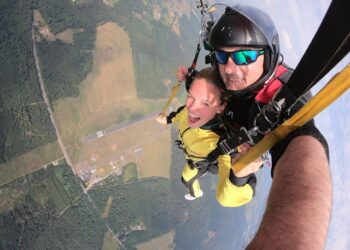Yes, there is a weight limit for skydiving. Learn why it exists, how it’s enforced, and how it affects your tandem or solo jump.
Skydiving is about freedom, thrill, and pushing limits, but when it comes to weight, there are hard lines that can’t be ignored. And while no one loves talking about body weight, transparency is essential in a sport where safety comes first.
Let’s be clear: skydiving isn’t about body shaming. The weight limit isn’t cosmetic. It’s physics, gear performance, and life-or-death engineering. Whether you’re 150 pounds or 250+, understanding how weight affects skydiving will ensure you’re not caught off guard on jump day, or turned away after a weigh-in.
What You'll Discover:
Is There a Weight Limit for Skydiving?
Yes. Every licensed dropzone around the world sets a maximum weight limit for tandem and solo skydives. This isn’t optional, it’s enforced every single jump.
In most U.S. dropzones:
The standard tandem skydiving weight limit is around 220 to 240 pounds (100–109 kg), fully clothed.
But it’s not a one-size-fits-all answer. Some dropzones accommodate heavier jumpers, up to 260 or even 300 pounds, but those jumps often include extra charges, special equipment, and instructor approval.
Why the Weight Limit Exists: The Physics of Falling
It all boils down to this: skydiving is not just falling, it’s controlled, precise, high-speed physics. Here’s why weight matters so much:
1. Parachute Safety Ratings
Every parachute system is certified with a maximum load capacity (known as the Total Suspended Weight). This includes:
- Your body weight
- Your tandem instructor’s weight
- The harness, parachute, and reserve gear (20–30 lbs)
Overloading the system puts both jumper and instructor at extreme risk during deployment.
2. Harness Fit and Security
Tandem harnesses are adjustable, but not infinitely. If someone exceeds the safe fit range, the harness may fail to secure properly or distribute force unevenly. That’s not a risk worth taking.
3. Landing Impact
Heavier bodies generate more momentum during descent. If landing is rough, and it sometimes is, extra weight increases injury risk for ankles, knees, or the instructor supporting the landing.
4. Instructor Safety
Tandem instructors carry more than their own body weight out the plane door. Managing another person in freefall, during parachute deployment, and especially during landing is physically demanding. Limits protect them too.
Typical Weight Limits by Country
Here’s how weight limits generally stack up across regions:
| Country | Tandem Weight Limit | Notes |
| USA | 220–240 lbs (100–109 kg) | Some allow up to 260–300 lbs with surcharge |
| UK | 220 lbs (100 kg) | Strict adherence |
| Australia | 242–265 lbs (110–120 kg) | Case-by-case basis |
| Canada | 230–250 lbs (104–113 kg) | Many require approval if over 220 lbs |
| New Zealand | 220–230 lbs (100–104 kg) | Limited heavier jumper options |
Note: These numbers vary by dropzone, weather conditions, and instructor comfort level.
Is There a Minimum Weight to Skydive?
Surprisingly, yes.
Most dropzones require you to weigh at least 90–100 lbs (40–45 kg) to tandem skydive.
Why? Because if you’re too light, you won’t balance out the harness properly with the instructor. That can make the fall unstable or create a dangerous imbalance during parachute deployment.
What If You’re Over the Limit?
This doesn’t mean you’re banned for life. It means you’ll need to be selective and realistic.
Option 1: Call Ahead
Don’t guess. Always contact the dropzone before booking. Ask:
- What is your max tandem weight limit?
- Do you allow exceptions?
- Are there surcharges or special gear used?
Transparency helps both you and the facility prepare.
Option 2: Specialized Dropzones
Some dropzones cater to plus-size jumpers, with:
- Larger tandem harnesses
- Higher-rated parachute rigs
- Experienced instructors for higher weight brackets
These jumps may cost more (typically $20–$50 extra), but safety comes first.
How Dropzones Enforce the Weight Limit
They’re not subtle. Every jumper gets weighed. No exceptions.
And yes, they weigh you fully clothed, usually during check-in. If you’re even 1–2 pounds over the posted limit, they can, and likely will, refuse the jump for safety and liability reasons.
If you’ve listed a lower weight on the reservation form to “get in the door,” expect a refund denial and disappointment.
What If You’re Close to the Limit?
Some tips if you’re hovering near 230–240 lbs:
- Wear light, non-bulky clothes on jump day.
- Empty your pockets.
- Don’t carry backpacks or heavy accessories.
- Hydrate, but avoid large meals right before.
A few pounds could make the difference between skydiving today or not at all.
Can You Lose Weight for Skydiving?
If you’re serious about jumping but over the cutoff, some use it as a short-term fitness goal. A structured plan with moderate weight loss (10–20 lbs) can open that plane door for you.
However, don’t crash diet. If you’re feeling weak or dizzy, jumping at 13,000 feet isn’t the move.
Weight Limits for Solo Skydiving
Once you’re licensed (via AFF training), the rules change slightly.
You’ll use gear designed for your weight alone, not tandem systems. Most modern solo rigs can handle up to 254–300 lbs, depending on canopy type and configuration.
Still, you’ll need to:
- Fit into a proper harness
- Be cleared during ground training
- Pass a medical self-certification (or in some countries, a physician-signed form)
Indoor Skydiving Weight Limits
If you can’t skydive outdoors yet, indoor skydiving (like iFLY) offers a great alternative.
Most iFLY locations enforce a max weight of 250–300 lbs.
Since the experience is wind tunnel-based, not altitude-based, the risk profile is lower, but physics still applies. The stronger the fan power required, the greater the chance of safety hazards.
Common Myths About Skydiving and Weight
Let’s bust a few:
Myth: “They won’t really weigh me.”
Truth: They absolutely will. Silently hoping to sneak by doesn’t work.
Myth: “If I sign a waiver, I can jump at any size.”
Truth: Waivers don’t override equipment limits or insurance coverage.
Myth: “I’m muscular, not fat, so I’m good.”
Truth: Weight is weight. Even lean body mass impacts gear ratings.
Myth: “I’ll be treated differently if I’m heavier.”
Truth: Reputable dropzones treat every jumper with respect and discretion. Many instructors work with heavier clients daily.
What Happens If You’re Denied on Jump Day?
- You may forfeit your deposit, especially if you misrepresented your weight on booking forms.
- Some dropzones will reschedule or refer you to a location that accommodates your weight class.
- If weight concerns are weather-related (e.g., high winds), you might be rebooked for a calmer day.
The best strategy? Be honest, and plan ahead.
Key Takings
- Most skydiving centers have a weight limit of 220–240 lbs, fully clothed.
- Limits are based on parachute certification, gear safety, and instructor protection, not body image.
- Some dropzones allow jumps up to 260–300 lbs, with proper equipment and possible surcharges.
- All jumpers get weighed, don’t guess, and don’t lie on the form.
- Indoor skydiving is a great alternative if you’re above the outdoor limit.
- Skydiving while overweight is possible, but only with the right prep, equipment, and dropzone.
- Safety always comes first. Respect the rules, and the sky will welcome you.





